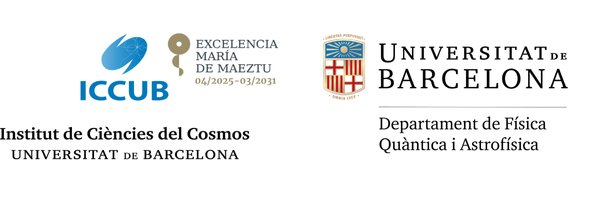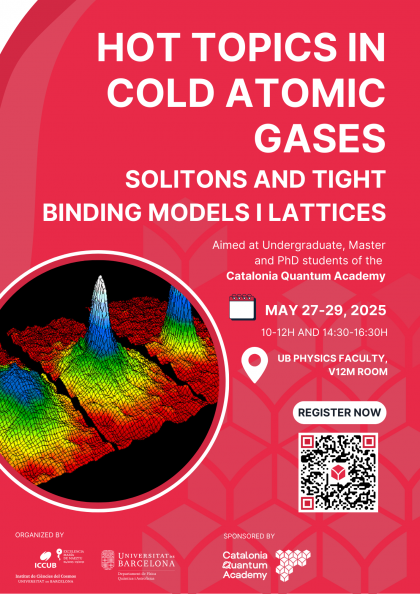Cold Atomic Gases: Solitons and Tight Binding Models in Lattices
Cold atomic gases provide a rich platform for exploring a wide variety of quantum phenomena, such as Bose-Einstein condensation (BEC), superfluidity, entanglement and correlations. In BEC, bosonic atoms condense into a single quantum state and behave as a coherent macroscopic entity.
One of the most exciting developments in the study of cold atomic gases has been the use of optical lattices, periodic potentials created by interfering laser beams. These lattices can be used to simulate the behavior of electrons in solid-state materials, providing a controllable environment for investigating many-body physics. Within optical lattices, the behavior of atoms can often be described using the tight-binding model, which treats atoms as being localized at lattice sites and hopping to neighboring sites under the influence of quantum tunneling. This model allows for the exploration of phenomena like band gaps, Mott insulators, and topologically protected states.
Another fascinating feature that arises in these systems is the formation of matter wave solitons; localized, stable wave packets that maintain their shape as they propagate. In the context of cold atomic gases, solitons can form in both Bose-Einstein condensates and in spinor gases, where interactions between the atoms lead to nonlinear effects that stabilize the solitonic structures. These solitons serve as a key tool for studying the dynamics of quantum fluids and non-equilibrium phenomena.
Together, cold atomic gases in optical lattices represent a versatile and powerful experimental platform for exploring fundamental questions in quantum mechanics, condensed matter physics, and beyond, including quantum simulations, quantum information, and the dynamics of strongly correlated systems.
In this course, students will explore the fundamental aspects of nonlinear waves and tight-binding models in ultracold atomic gases, guided by two leading experts in the field. Core concepts will be introduced through theoretical lectures and selected topics in the study of solitons will be complemented by hands-on numerical simulations, to illustrate the behavior of these complex systems in practice.
Part 1: Overview of Superfluid Solitons
Antonio Muñoz Mateo*
Departamento de Física, Universidad de La Laguna, Tenerife 38200, Spain
Antonio Muñoz Mateo is a faculty member of Universidad de La Laguna at Tenerife, Canary Islands.
He has expertise in the theoretical analysis of Bose-Einstein condensates and nonlinear waves, and his research interests focus on the physics of diverse quantum analogues of ultracold-atom systems.
*ammateo@ull.edu.es
Abstract
The first dark and bright superfluid solitons were realized in early experiments with Bose-Einstein condensates of ultracold gases [1, 2]. Long before, optical solitons and, much before them, solitons in water channels were discovered and thoroughly studied [3, 4]. Solitons are solitary waves that remain undisturbed during their motion and even after collisions between them. They appear in nonlinear systems from the balance between dispersion and nonlinearity, and, most of the times, are restricted to live in (quasi) one-dimensional systems, since extra dimensions open ways of decay into different states. They are called bright or dark solitons depending on the enhancement or depletion, respectively, of the underlying media. As waves, solitons are characterized by amplitude and phase; as localized, particle-like objects they have a definite mass and velocity. Despite their common features, modeling solitons depends on the media where they exist: while the Navier-Stokes or the Korteweg-de Vries equations can model solitons in water, the nonlinear-Schrödinger or the Lugiato-Lefever equations recreate solitons in optics. In superfluids, the Ginzburg-Landau or the Gross-Pitaevskii equations provide mean-field models for soliton dynamics. In this set of lectures, we will focus on the latter equation to study the features of superfluid solitons in Bose-Einstein condensates (BECs) by means of analytical and numerical techniques, and will make connections with recent experiments in ultracold gases, where a diverse multiplicity of superfluid solitons can be realized.
Contents
Numerical simulations will be performed by provided codes in Julia Programming Language
https://julialang.org
Lecture 1: Properties of stationary solitons.
• Linear versus nonlinear equations of motion
• BECs and the Gross-Pitaevskii equation: comparison with Euler equations [5]
• Attractively interacting (self-focusing) versus repulsively interacting (defocusing) media
• Localized states: Bright and dark solitons. Analytical solutions in 1D systems [5, 6]
Lecture 2: Soliton dynamics in scalar systems.
• Bright solitons [7]
– Free versus trapped systems, and one- versus multi-dimensional systems
– Multi-soliton states and collisions [8]
– Modulational instability
• Dark solitons [9]
– Oscillations and collisions in harmonically trapped systems.
– Decay into vortices in multi-dimensional systems [10]
Lecture 3: Solitons in different backgrounds: lattices, chirality, gauge fields, etc.
• Periodic potentials: Gap solitons [11]
• Synthetic gauge fields: Solitons and hysteresis cycles [12, 13]
• Current-density interactions: Chiral solitons [14, 15]
• Pseudo-spinor BECs: Magnetic solitons and/or Josephson vortices. [16, 17]
References
[1] S Burger, K Bongs, S Dettmer, W Ertmer, K Sengstock, A Sanpera, G V Shlyapnikov, and M Lewenstein. Dark solitons in Bose–Einstein condensates. Phys. Rev. Lett, 83(25):5198, 1999.
[2] L Khaykovich, F Schreck, G Ferrari, T Bourdel, J Cubizolles, L D Carr, Y Castin, and C Salomon. Formation of a matter-wave bright soliton. Science, 296(5571):1290–1293, 2002.
[3] J M Dudley, C Finot, G Genty, and R Taylor. Fifty years of fiber solitons. Optics and Photonics News, 34(5):26–33, 2023.
[4] EM De Jager. On the origin of the Korteweg-de Vries equation. arXiv preprint math/0602661, 2006.
[5] L Pitaevskii and S Stringari. Bose-Einstein condensation and superfluidity. Oxford University Press, 2016. Ch. 5: Nonuniform Bose gases at zero temperature.
[6] S Coleman. Aspects of symmetry: selected Erice lectures. Cambridge University Press, 1988. Ch. 6: Classical lumps and their quantum descendants.
[7] TP Billam, AL Marchant, SL Cornish, SA Gardiner, and NG Parker. Bright solitary matter waves: formation, stability and interactions. Spontaneous Symmetry Breaking, Self-Trapping, and Josephson Oscillations, pages 403–455, 2013.
[8] JP Gordon. Interaction forces among solitons in optical fibers. Optics letters, 8(11):596–598, 1983.
[9] DJ Frantzeskakis. Dark solitons in atomic Bose–Einstein condensates: from theory to experiments. Journal of Physics A: Mathematical and Theoretical, 43(21):213001, 2010.
[10] A Muñoz Mateo and J Brand. Chladni solitons and the onset of the snaking instability for dark solitons in confined superfluids. Physical review letters, 113(25):255302, 2014.
[11] P J. Y. Louis, E A. Ostrovskaya, C M. Savage, and Y S. Kivshar. BECs in optical lattices: Band-gap structure and solitons. Phys. Rev. A, 67:013602, 2003.
[12] S Eckel, J G Lee, F Jendrzejewski, N Murray, C W Clark, C J Lobb, W D Phillips, M Edwards, and G K Campbell. Hysteresis in a quantized superfluid atomtronic circuit. Nature, 506(7487):200–203, 2014.
[13] A. Muñoz Mateo, A. Gallemí, M. Guilleumas, and R. Mayol. Persistent currents supported by solitary waves in toroidal BECs. Phys. Rev. A, 91:063625, 2015.
[14] R Jackiw. A nonrelativistic chiral soliton in one dimension. Journal of Nonlinear Mathematical Physics, 4(3):261–270, 1997.
[15] A Frölian, C S Chisholm, E Neri, C R Cabrera, R Ramos, A Celi, and L Tarruell. Realizing a 1D topological gauge theory in an optically dressed BEC. Nature, 608(7922):293–297, 2022.
[16] VM Kaurov and AB Kuklov. Josephson vortex between two atomic Bose-Einstein condensates. Physical Review A, 71(1):011601, 2005.
[17] C Qu, L P Pitaevskii, and S Stringari. Magnetic solitons in a binary Bose-Einstein condensate. Physical Review Letters, 116(16):160402, 2016.
Part 2: Tight binding models for ultracold atoms in optical lattices: general formulation and applications
Michele Modugno*
IKERBASQUE, Univ Basque Country, UPV/EHU, Dept. Phys, Bilbao 48080, Spain
Michele Modugno is Ikerbasque Research Professor and Distinguished Researcher at the University of the Basque Country UPV/EHU.
His expertise lies in the theory and phenomenology of ultracold quantum gases.
His research activity covers various topics, including ultracold atoms in optical lattices, quantum mixtures, self-bound quantum droplets, dipolar condensates, and supersolids.
* michele.modugno@ehu.eus
Contents
Lecture 1
• Tight-binding models for ultracold atoms in optical lattices.
• Maximally localized Wannier functions for composite bands.
• Double-well periodic potentials and honeycomb lattices.
References
N. Marzari and D. Vanderbilt, Maximally localized generalized Wannier functions for composite energy bands, Phys. Rev. B 56, 12847 (1997).
M. Modugno and G. Pettini, Maximally localized Wannier functions for ultracold atoms in one- dimensional double-well periodic potentials, New J. Phys. 14, 055004 (2012).
J. Ibañez-Azpiroz, A. Eiguren, A. Bergara, G. Pettini, and M. Modugno, Tight binding models for ultracold atoms in honeycomb optical lattices, Phys. Rev. A 87, 011602(R) (2013).
M. Modugno, J. Ibañez-Azpiroz, and G. Pettini, Tight-binding models for ultracold atoms in optical lattices: general formulation and applications, Sci. China-Phys. Mech. Astron. 59, 660001 (2016).
Lecture 2
• The Haldane model: a paradigmatic model for topological insulators.
• The Peierls substitution: definition, use, and limitations.
• Ab initio analysis of the Haldane topological phase diagram for cold atoms in artificial gauge fields.
References
F. D. M. Haldane, Model for a Quantum Hall Effect Without Landau Levels: Condensed-Matter Realization of the “Parity Anomaly”, Phys. Rev. Lett. 61, 2015 (1988).
J. Ibañez-Azpiroz, A. Eiguren, A. Bergara, G. Pettini, and M. Modugno, Breakdown of the Peierls substitution for the Haldane model with ultracold atoms, Phys. Rev. A 90, 033609 (2014).
J. Ibañez-Azpiroz, A. Eiguren, A. Bergara, G. Pettini, and M. Modugno, Ab initio analysis of the topological phase diagram of the Haldane model, Phys. Rev. B 92, 195132 (2015).
T. B. Boykin, R. C. Bowen, and G. Klimeck, Electromagnetic coupling and gauge invariance in the empirical tight-binding method, Phys. Rev. B 63, 245314 (2001).
Lecture 3
• Realization of the Haldane topological phase diagram with ultracold atoms.
• Driven honeycomb lattices and Floquet engineering.
• Stroboscopic and non-stroboscopic Floquet Hamiltonians.
References
G. Jotzu, M. Messer, R. Desbuquois, M. Lebrat, T. Uehlinger, D. Greif, and T. Esslinger, Experimental realization of the topological Haldane model with ultracold fermions, Nature (London) 515, 237 (2014).
M. Modugno and G. Pettini, Correspondence between a shaken honeycomb lattice and the Haldane model, Phys. Rev. A 96, 053603 (2017).
N. Goldman and J. Dalibard, Periodically driven quantum systems: Effective Hamiltonians and engineered gauge fields, Phys. Rev. X 4, 031027 (2014).
M. Holthaus, Floquet engineering with quasienergy bands of periodically driven optical lattices, J. Phys. B 49, 013001 (2016).
M. Bukov, L. D’Alessio, and A. Polkovnikov, Universal high-frequency behavior of periodically driven systems: From dynamical stabilization to Floquet engineering, Adv. Phys. 64, 139 (2015).
A. R. Puente-Uriona, G. Pettini, and M. Modugno, Topological Phase Diagram of Optimally Shaken Honeycomb Lattices: A Dual Perspective from Stroboscopic and Non-Stroboscopic Floquet Hamiltonians, Phys. Rev. Research 6, 023244 (2024).
ORGANIZED BY:

SPONSORED BY:

